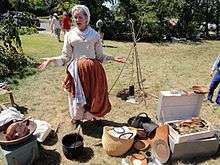Camp follower
| Look up camp follower in Wiktionary, the free dictionary. |

Camp follower is a term used to identify civilians and their children who follow armies. There are two common types of camp followers; first, the wives and children of soldiers, who follow their spouse or parent's army from place to place; the second type of camp followers have historically been informal army service providers, servicing the needs of encamped soldiers, in particular selling goods or services that the military does not supply—these have included cooking, laundering, liquor, nursing, sexual services and sutlery.[1]
General history
From the beginning of organized warfare until the end of the 19th century, European and American armies heavily depended on the services of camp followers. These services included delivery and preparation of provisions and transportation of supplies, which augmented the official military support structure.[2] Camp followers usually accompanied the baggage train and they often outnumbered the army itself, adding to its logistical problems.[3] Camp followers were both a support and drain on an army. They provided valuable services. Soldiers' wives washed, sewed, nursed and even acted as servants. However, camp followers needed to be fed, clothed, transported and guarded. They also had to be policed; camp followers could be among the most determined scavengers and looters after battles and whilst on the march.
From the middle of the 19th century on, the creation of organized and resourced transport, medical, ordnance and supply corps as an integral part of regular armies marked the end of reliance on camp followers in most European armies. However, in much of the world the concept of numerous civilian workers, family members and hangers-on accompanying armies survived into the 20th century, either for reasons of local culture or in the absence of formal support services. A notable example was the Mexican Revolution of 1910-20, where female soldaderas filling traditional camp roles, carrying equipment and often acting as combatants were a marked feature of Zapatista, Villistas and Federale forces at all times.[4]
United States
History
In United States history, camp followers were an important part of servicing and supplying the army during the Revolutionary War. There were also camp followers on both the Union and Confederate sides of the American Civil War.[5] However, a major difference between the armies of the American Revolution and the Civil War was the presence of women and children. By the time of the civil war, camps and campaigns included far fewer wives, children and other soldiers' relatives as part of the military group. Women still served as nurses in hospitals and in other limited support roles, but were not present in the same way in the American Civil War.[6]
Survivals in modern warfare
Today's military operations in combat zones, such as the Iraq War that began with US invasion in 2003 or the Afghan War that began in 2001, feature extensive roles played by civilian contractors in providing logistic support for the armed forces. This has led journalists and historians to liken the phenomenon to that of camp followers.[7]
Other contemporary usage
"Camp-follower" has also been used to describe the modern families of military personnel who accompany soldiers while traveling; either during active military campaigns (more common in less-developed countries), or during peacetime military deployments (more common in developed countries), especially moving from military base to military base in a nomadic lifestyle (more common in developed countries).
Modern camp-follower children are now more often called military brats in several English-speaking countries. In the United States, Canada and Great Britain, the term refers specifically to the mobile children of career soldiers, who traditionally have been camp or base followers.[8] In the United States this practice of base-following, or camp-following, dates all the way back to the beginning of the Republic.[9]
At least 12 million living Americans aged between 18 and 80 grew up without home towns and within the U.S. military—moving from base to base around the United States and the world.[10] Work has been done to document and describe the unique subculture of American military brats.[11][12]
Multigenerational aspect: 38% of currently living American military brats are the children of military brats: In many career military families, this tradition goes back for generations. Some consider the modern American U.S. subculture of military brats and American multi-generational career military families to border on being a distinct ethnic group.[13] Precedents of such distinct ethnic groups exist in many parts of the world and throughout history, for example the Ukrainian Cossacks, the Samurai class in Japan, and the Kayani of Pakistan, to name just a few military-derived ethnicities.
Some work has also been done to document and describe military brat subcultures from other English speaking countries as well.
See also
- Tross Medieval German camp followers
- Vivandière - an account of sutlers and canteen-keepers
Notes
- ↑ Holmes 2001, p. 170.
- ↑ It included civilian merchants, contractors and teamsters, as well as family members such as wives, attached to the troops. Cardoza, Thomas (2010). Intrepid Women: Cantinières and Vivandières of the French Army. Indiana University Press. p. passim. ISBN 978-0-2533-5451-8.
- ↑ Holmes 2001, p. 171.
- ↑ Jowett, Philipp (2006). The Mexican Revolution 1910-20. Osprey Publishing Ltd. p. 55. ISBN 1 84176 989 4.
- ↑ http://civilwarlogowear.com/articles/why.shtml
- ↑ http://civilwarlogowear.com/articles/why.shtml
- ↑ http://historynewsnetwork.org/article/20067
- ↑ Wertsch 1992.
- ↑ Musil 2005.
- ↑ Musil 2005.
- ↑ Musil 2005.
- ↑ Wertsch 1992.
- ↑ Wertsch 1992.
References
- Holmes, Richard; ed (2001). The Oxford Companion to Military History. Oxford: Oxford University Press. ISBN 0-19-866209-2.